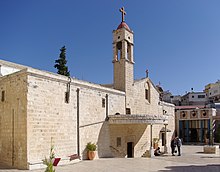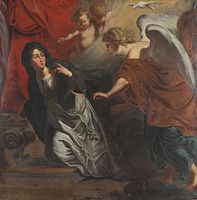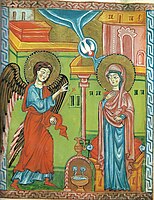Annunciation
The Annunciation (from the

According to Luke 1:26,
The Annunciation is a key topic in Christian art in general, as well as in Marian art in the Catholic Church, having been especially prominent during the Middle Ages and Renaissance. A work of art depicting the Annunciation is sometimes itself called an Annunciation.
Religious sources
Gospel of Luke
The Gospel of Luke recounts the Annunciation to the Blessed Virgin Mary:
And Mary said to the angel: How shall this be done, because I know not man?
And the angel answering, said to her: The Holy Ghost shall come upon thee, and the power of the most High shall overshadow thee. And therefore also the Holy which shall be born of thee shall be called the Son of God. And behold thy cousin Elizabeth, she also hath conceived a son in her old age; and this is the sixth month with her that is called barren: Because no word shall be impossible with God.
And Mary said: Behold the handmaid of the Lord; be it done to me according to thy word. And the angel departed from her.
— Luke 1:26–38[6]
The archangel Gabriel's greeting to Mary forms the first part of the prayer Hail Mary. Mary's response to the archangel forms the second versicle and response of the Angelus prayer. Various Bible translations also give Gabriel's salutation as a variation on: "Greetings, you who are highly favored!" (Luke 1:28, NIV).[7]
Gospel of Matthew
A separate, briefer and different annunciation is that given to Joseph in Matthew 1:18:
Now the generation of Christ was in this wise. When as his mother Mary was espoused to Joseph, before they came together, she was found with child, of the Holy Ghost. Whereupon Joseph her husband, being a just man, and not willing publicly to expose her, was minded to put her away privately.
But while he thought on these things, behold the angel of the Lord appeared to him in his sleep, saying: Joseph, son of David, fear not to take unto thee Mary thy wife, for that which is conceived in her, is of the Holy Ghost. And she shall bring forth a son: and thou shalt call his name JESUS. For he shall save his people from their sins.
Now all this was done that it might be fulfilled which the Lord spoke by the prophet, saying: Behold a virgin shall be with child, and bring forth a son, and they shall call his name Emmanuel, which being interpreted is, God with us.
— Matthew 1:18–23[8]
Apocryphal Gospel of James
There is a different version contained in the apocryphal Gospel of James, which includes a first appearance of the archangel at the well.[n 1]
Manuscript 4Q246
Manuscript 4Q246 of the Dead Sea Scrolls reads:
[X] shall be great upon the earth. O king, all people shall make peace, and all shall serve him. He shall be called the son of the Great God, and by his name shall he be hailed as the Son of God, and they shall call him Son of the Most High.
— Dead Sea scrolls manuscript Q4Q246, translated in "An Unpublished Dead Sea Scroll Text Parallels Luke's Infancy Narrative", Biblical Archaeology Review, April/May 1990[9]
It has been suggested that the similarity in content is such that Luke's version may in some way be dependent on the Qumran text.[10]
In the Quran

The Annunciation is described in the Quran, in Surah Al Imran, verses 45–51:
˹Remember˺ when the angels proclaimed, “O Mary! Allah gives you good news of a Word from Him, his name will be the Messiah, Jesus, son of Mary; honoured in this world and the Hereafter, and he will be one of those nearest ˹to Allah˺.
Location
Both the Roman Catholic and Eastern Orthodox Churches hold that the Annunciation took place at Nazareth, but differ slightly as to the precise location. Catholic tradition holds that the Annunciation occurred in Mary's home, while Eastern Orthodox tradition holds that it occurred at the town well, known as Mary's Well. The Basilica of the Annunciation marks the site preferred by the former, while the Greek Orthodox Church of the Annunciation (around half a mile away) marks that preferred by the latter.
Feast day
Catholicism
The
When the calendar system of
Along with Easter, 25 March was used as the New Year's Day in many pre-modern Christian countries.[12] The holiday was moved to January 1 in France by Charles IX's 1564 Edict of Roussillon. In England, the feast of the Annunciation came to be known as Lady Day,[13] and Lady Day marked the beginning of the English new year until 1752.[13] Also in England, the 1240 Synod of Worcester banned all servile work during the Feast of the Annunciation, making it a day of rest.[14]
Eastern Christianity

This section needs additional citations for verification. (February 2016) |
In the

The traditional hymn (troparion) for the feast of the Annunciation goes back to Athanasius of Alexandria. It runs:[15]
As the action initiating the
In art
| Part of a series on the |
| Mariology of the Catholic Church |
|---|
 |
|
Catholicism portal |
The Annunciation has been one of the most frequent subjects of
Works on the subject have been created by artists such as Sandro Botticelli, Leonardo da Vinci, Caravaggio, Duccio, Henry Ossawa Tanner, Jan van Eyck, and Murillo among others. The mosaics of Pietro Cavallini in Santa Maria in Trastevere in Rome (1291), the frescos of Giotto in the Scrovegni Chapel in Padua (1303), Domenico Ghirlandaio's fresco at the church of Santa Maria Novella in Florence (1486), and Donatello's gilded sculpture at the church of Santa Croce, Florence (1435) are famous examples.
-
The Annunciation by Johann Christian Schröder, c. 1690
-
The Annunciation by Paolo de Matteis, 1712, Saint Louis Art Museum, Saint Louis. The white lily in the angel's hand is symbolic of Mary's purity[n 3] in Marian art.[19]
-
The Annunciation in Armenian art by Toros Taronetsi, 1323
Music
See also
- Angelus
- Annunciade, religious order
- Annunciation of Ustyug
- Basilica of the Annunciation
- Chronology of Jesus
- Expectation of the Blessed Virgin Mary
- Greek Orthodox Church of the Annunciation, Nazareth
- Incarnation (Christianity)
- Order of the Most Holy Annunciation
- Roman Catholic Marian art
- Perpetual Virginity of Mary
Notes
- ^ For full text of the apocryphal Gospel of James, see for instance here under "Chapter 11: The Annunciation".
- ^ In Eastern Orthodoxy, Mary is referred to as Theotokos (Greek: Θεοτόκος, from Θεο, theo-, 'God', and τοκος, tokos, 'bearer').
- ^ Purity is a wider concept than virginity, which is comprised within it, but which relates to a physical aspect only of purity.
Citations
- ^ "Lessons for Holy Days » The Prayer Book Society of Canada". Prayerbook.ca. 23 March 2014. Archived from the original on 9 October 2020. Retrieved 27 March 2014.
- ^ a b c d e EB (1878).
- ^ Luke 1:31
- ^ Luke 1:26
- ISBN 0-8146-2862-1.
- ^ Luke 1:26–38
- ^ Luke 1:28
- ^ Matthew 1:18–23
- ^ Dead Sea scrolls manuscript Q4Q246, translated in "An Unpublished Dead Sea Scroll Text Parallels Luke's Infancy Narrative", Biblical Archaeology Review, April/May 1990
- ISBN 0-567-08468-X.
- ^ Holweck, Frederick George (1907). . In Herbermann, Charles (ed.). Catholic Encyclopedia. Vol. 1. New York: Robert Appleton Company.
- ^ Groves, Marsha (2005), Manners and Customs of the Middle Ages, p. 27
- ^ a b EB (1911b).
- ^ EB (1911a).
- ISBN 978-0-8232-3337-3page 85
- ISBN 0-19-866165-7page 23
- ISBN 0-7546-3603-8pages 158–159
- ISBN 978-1-56854-557-8.
- ISBN 0-313-29329-5.
References
- Baynes, T. S., ed. (1878), , Encyclopædia Britannica, vol. 2 (9th ed.), New York: Charles Scribner's Sons, p. 90
- Chisholm, Hugh, ed. (1911), , Encyclopædia Britannica, vol. 2 (11th ed.), Cambridge University Press, p. 78
- Chisholm, Hugh, ed. (1911), , Encyclopædia Britannica, vol. 16 (11th ed.), Cambridge University Press, p. 62
Further reading
- Baxter, Roger (1823). . Meditations For Every Day In The Year. New York: Benziger Brothers.
- Knecht, Friedrich Justus (1910). . A Practical Commentary on Holy Scripture. B. Herder.


![The Annunciation by Paolo de Matteis, 1712, Saint Louis Art Museum, Saint Louis. The white lily in the angel's hand is symbolic of Mary's purity[n 3] in Marian art.[19]](http://upload.wikimedia.org/wikipedia/commons/thumb/9/9e/Paolo_de_Matteis_-_The_Annunciation.jpg/175px-Paolo_de_Matteis_-_The_Annunciation.jpg)

